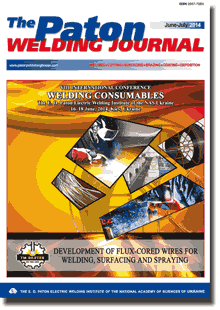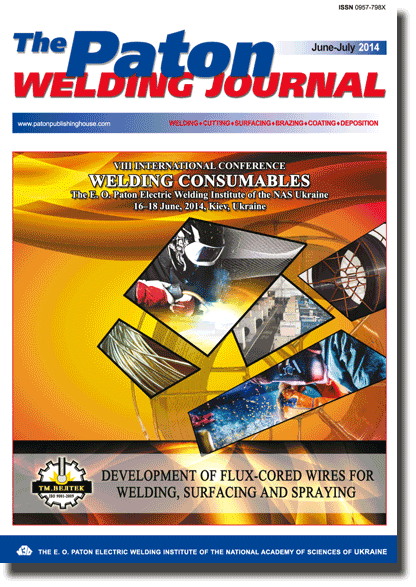| 2014 №06 (37) |
DOI of Article 10.15407/tpwj2014.06.38 |
2014 №06 (39) |

The Paton Welding Journal, 2014, #6-7, 177-189 pages
THICKNESS DIFFERENCE OF ELECTRODE COATINGS CAUSED BY ELASTIC TURBULENCE OF ELECTRODE COMPOUNDS UNDER CONDITION OF NONISOTHERMAL PRESSURE FLOW
A.E. MARCHENKO
E.O. Paton Electric Welding Institute, NASU. 11 Bozhenko Str., 03680, Kiev, Ukraine. E-mail: office@paton.kiev.ua
Abstract
Generalized and analyzed are the results of investigations carried at the E.O. Paton Electric Welding Institute on technological properties of electrode compounds, promoting thickness difference of electrode coatings. The investigations were carried out using capillary viscosimeter of fixed flow - rheometer with electric drive, which can be used for simulation of the conditions of compound extrusion application over the electrode rods, typical for commercial electric extrusion presses. Thus, specific pressure on compound under condition of stationary flow achieves 60-75 MPa, average gradient of shear rate is gradually regulated in the ranges from 1 to 5·103 s-1, and it makes to 65·103 s-1 for separate types of compound. The compounds for rutile, low-hydrogen and cellulose electrodes, differing by wide range of consistency indices, were investigated. In addition to shear and longitudinal viscosity, the investigations were carried out on a range of change of their modulus of shear elasticity, period of relaxation, criterion of Reynolds elastic turbulence, elastic potential and reversible (elastic) deformation. The results received were analyzed from point of view of existing phenomenological theory of elastic turbulence of polymer materials, combining viscosity and elasticity properties. It is successfully used in the course of many years in rheology of melts and solutions of high-molecular compounds for solving of technological problems of their extrusion processing. Variants of elastic turbulence, detected in capillary and pre-capillary zones, were analyzed. Quality relation of this phenomenon to appearance and nature of coating thickness difference in course of real extrusion application of compound over the electrode rods was shown. 24 Ref., 4 Tables, 9 Figures.
Keywords: arc welding, coated electrodes, coating thickness difference, electrode compounds, viscosity, elasticity modulus, elastic turbulence
Received: 22.04.14
Published: 28.09.14
References
1. Marchenko, A.E. (2000) Coating thickness difference as a factor of process state and quality of manufacture of welding electrodes. In: Proc. of Sci.-Techn. Seminar on Electrode Manufacturing on the Threshold of New Millennium (St.-Petersburg, 22-26 May 2000), 124-125. Cherepovets: Elektrod.
2. Vornovitsky, I.N. (1989) Coating thickness difference as a main factor of quality of electrodes. Svarochn. Proizvodstvo, 4, 7-19.
3. Mayasaka, K., Oshiba, F., Akamatsu, T. (1982) Effect eccentricity of the coating upon the deposition of weld metal. J. JWS, 7, 47-55.
4. Ovchinnikov, V.A., Bazhenov, V.V. (1978) Influence of electrode coating geometry and presence of defects in it on reliability of melted metal shielding from air action. Svarochn. Proizvodstvo, 5, 39-40.
5. Pokhodnya, I.K., Makarenko, V.D., Milichenko, S.S. (1985) Influence of coating eccentricity on welding-technological properties of electrodes and quality of deposited metal. Avtomatich. Svarka, 11, 20-22.
6. Stepanosov, A.R. (1989) Expert judgement of causes of coating thickness difference of welding electrode. Svarochn. Proizvodstvo, 4, 7-9.
7. Belkin, I.M., Vinogradov, G.V., Leonov, A.I. (1967) Rotary devices. Measurement of viscosity and physico-mechanical characteristics of materials. Moscow: Mashinostroenie.
8. Vinogradov, G.V., Malkin, A.Ya. (1977) Rheology of polymers. Moscow: Khimiya.
9. Marchenko, A.E., Gnatenko, M.F. (1980) Peculiarities of flow of electrode compounds detected by capillary plastometer: SMEA Inform. Doc., Issue 1, 106-117. Kiev: Naukova Dumka.
10. Bagley, E.B. (1957) End correction in the capillary flow of polyethylene. J. Appl. Phys., 28(5), 624-627. https://doi.org/10.1063/1.1722814
11. Cogswell, F.N. (1972) Converging flow of polymer melts in extrusion dies. Polymer Eng. and Sci., 12(2), 64-70. https://doi.org/10.1002/pen.760120111
12. Marchenko, A.E. (2011) About rheological properties of electrode compounds in convergent zone during electrode extrusion. In: Proc. of 6th Int. Conf. on Welding Consumables. Development. Technology. Manufacture. Quality. Competitiveness (Krasnodar, 6-9 June 2011), 223-232.
13. Shoff, R.N., Cancio, L.V., Chida, M. (1977) Extrusial flow of polymer melts. Transact. of Soc. of Rheology, 21(3), 429-434. https://doi.org/10.1122/1.549468
14. Khan, Ch.D. (1979) Rheology in processes of recycling of polymers. Moscow: Khimiya.
15. Malkin, A.Ya., Leonov, A.I. (1963) On criteria of instability of shear deformation conditions of elastic-viscous polymer systems. Doklady AN SSSR, 151(2), 380-383.
16. Philippoff, W., Gaskins, F.H. (1958) The capillary experiment in rheology. Transact. of Soc. of Rheology, 263-284. https://doi.org/10.1122/1.548832
17. Sokolov, E.V. (1950) Electrodes with high quality coating and their production. Avtogen. Delo, 11, 26-29.
18. Klementov, V.I. (1953) Liquid glass as a material of electrode coatings for electric arc welding: Syn. of Thesis for Cand. of Techn. Sci. Degree. Moscow.
19. Marchenko, A.E., Skorina, N.V. et al. (1972) State-of-the-art and prospects of improvement of technology and equipment for manufacture of welding electrodes. In: Proc. of All-Union Conf. on Welding Consumables (Kiev, 31 Oct.-3 Nov. 1972), Pt2, 210-250.
20. Marchenko, A.E., Shkurko, S.A. (1973) Control of electrode compounds by conic plastometer. In: Proc. of Short-Term Seminar on Electrodes and Fluxes for Electric Arc Welding (Leningrad, 12-14 March 1973), 22-32.
21. Bibik, E.E. (1981) Rheology of dispersion systems. Leningrad: LGU.
22. Marchenko, A.E., Skorina, N.V., Sidlin, Z.A. et al. (1992) Investigation of viscosity of liquid glasses under electrode extrusion pressure. In: New Welding and Surfacing Materials and their Application in Industry: Proc. of Sci.-Techn. Seminar Dedicated to 100th Anniversary of K.V. Petranya (St.-Petersburg, 19-20 May 1992), 43-49.
23. Mitsubishi, N., Aoyagi, Y. (1973) Non-newtonian fluid flow in an eccentric annulus. J. Chem. Eng. of Japan, 6(5), 402-408. https://doi.org/10.1252/jcej.6.402
24. Marchenko, A.E., Gnatenko, M.F. (1992) Peculiarities of coating thickness difference formation detected by oscillography In: Abstr. of Sci.-Techn. Conf. on Metallurgy of Welding and Welding Consumables (St.-Petersburg, 1-2 June 1992), 98-100.
Suggested Citation
A.E. MARCHENKO (2014) THICKNESS DIFFERENCE OF ELECTRODE COATINGS CAUSED BY ELASTIC TURBULENCE OF ELECTRODE COMPOUNDS UNDER CONDITION OF NONISOTHERMAL PRESSURE FLOW. The Paton Welding J., 06, 177-189.The cost of subscription/purchase order journals or individual articles
| Journal/Currency | Annual Set | 1 issue printed |
1 issue |
one article |
| TPWJ/USD | 384 $ | 32 $ | 26 $ | 13 $ |
| TPWJ/EUR | 348 € | 29 € | 24 € | 12 € |
| TPWJ/UAH | 7200 UAH | 600 UAH | 600 UAH | 280 UAH |
| AS/UAH | 1800 UAH | 300 UAH | 300 UAH | 150 UAH |
| AS/USD | 192 $ | 32 $ | 26 $ | 13 $ |
| AS/EUR | 180 € | 30 € | 25 € | 12 € |
| SEM/UAH | 1200 UAH | 300 UAH | 300 UAH | 150 UAH |
| SEM/USD | 128 $ | 32 $ | 26 $ | 13 $ |
| SEM/EUR | 120 € | 30 € | 25 € | 12 € |
| TDNK/UAH | 1200 UAH | 300 UAH | 300 UAH | 150 UAH |
| TDNK/USD | 128 $ | 32 $ | 26 $ | 13 $ |
| TDNK/EUR | 120 € | 30 € | 25 € | 15 € |
AS = «Automatic Welding» - 6 issues per year;
TPWJ = «PATON WELDING JOURNAL» - 12 issues per year;
SEM = «Electrometallurgy Today» - 4 issues per year;
TDNK = «Technical Diagnostics and Non-Destructive Testing» - 4 issues per year.


